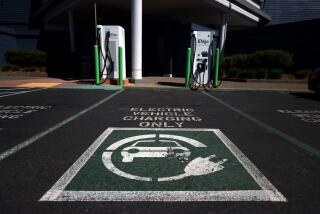Contradictions seen in alternative energy plan
WASHINGTON — President Bush’s proposals to reduce U.S. gasoline consumption by 20% in 10 years include more specific and ambitious new goals than in previous White House statements, but they also appear to rely on assumptions about energy markets, politics and technology that some experts say are debatable, and include some apparent contradictions.
In general, Bush’s proposal to boost alternative fuels such as ethanol was greeted with conditional enthusiasm by many scientists, environmentalists and members of Congress. His plan would require suppliers to include 35 billion gallons of alternative fuels in the nation’s vehicle fuel supply by 2017, up from the current 5 billion gallons.
“It is in our vital interest to diversify America’s energy supply -- and the way forward is through technology,” Bush said. “ ... We need to press on with battery research for plug-in and hybrid vehicles, and expand the use of clean diesel vehicles and biodiesel fuel. We must continue investing in new methods of producing ethanol -- using everything from wood chips, to grasses, to agricultural wastes.”
Bush also called for Congress to give him new authority to set vehicle fuel-economy rules. His plan would overhaul the decades-old vehicle fuel-economy program established after the Arab oil embargo, contending that technology can be deployed to “significantly improve fuel economy” without compromising vehicle safety.
But he rejected bipartisan calls for Congress to set new fuel economy rules, preferring to have the U.S. Department of Transportation set the standard. Under current law, the DOT can only set mileage standards for light trucks; raising the standard for passenger cars requires an act by Congress. The administration is expected to press Congress to allow DOT to set car standards using a vehicle size method rather than an overall fleet average.
Given the negative reaction Bush received from some Democrats on Capitol Hill on Tuesday, that possibility appears remote.
Environmentalists were skeptical that Bush’s proposal would lead to any significant increase in fuel economy rules.
Indeed, some aspects of the overall plan seemed to contradict each other. For one, Bush’s proposal to save gasoline by increasing vehicle fuel economy standards could be undermined by his call for greater use of alternative fuels. Ethanol, for example, gets less mileage than gasoline and, without a major technological breakthrough, requiring more of it could make it harder to increase fuel efficiency.
Philip E. Clapp, president of the National Environmental Trust, said that the president’s request for new legislation “letting him set standards basically model-by-model is something Detroit has pushed for years -- as a way to poke more loopholes in the current weak standards.”
Currently, automakers are required to have their fleets meet an average standard of 27.5 miles per gallon for passenger cars, and 21.6 miles per gallon for light trucks, which is due to increase to 24 mpg by 2011. Bush said mileage standards should be increased enough to reduce gasoline consumption by 5%, or 8.5 billion gallons, by 2017. Achieving that would require an average fuel economy improvement of 4% a year starting in the 2010 model year for cars, he said.
Bill Prindle, acting executive director of the American Council for an Energy Efficient Economy, a Washington think tank, called Bush’s fuel-economy proposal “pretty weak, plus it is totally noncommittal on substance and timing. It says, ‘Congress, don’t send us a standard, give us the power and we’ll issue a rule.’
“The 4% per year improvement is a nice hypothetical, but the last rule this administration issued, for light trucks in March 2006, achieved barely a 2% annual improvement. So I am not optimistic that DOT will come out with a stronger rule for cars, and especially not within two years.”
On Capitol Hill, Democrats and their environmental allies assailed Bush for failing to endorse mandatory limits on emissions blamed for global warming, commit to stricter vehicle miles-per-gallon rules or reconsider his past opposition to requiring a percentage of the nation’s electricity to be generated from alternative energy sources such as solar and wind power.
Rep. Henry A. Waxman (D-Los Angeles) called the energy proposals “the latest in a string of disappointments from this administration.”
Sen. Dianne Feinstein (D-Calif.), who is among a bipartisan group of lawmakers who has pushed for stricter miles-per-gallon rules, said the president’s proposal “doesn’t go nearly far enough.”
“The president has had the ability to make real changes to fuel efficiency with regard to light trucks for six years -- and he hasn’t made substantial increases. Why should we trust him now?” she asked, contending the only secure substantial increases in fuel economy are through legislation.
But any effort to go beyond what Bush is proposing could be politically difficult.
Previous efforts to pass much stricter fuel-economy standards have run into resistance not only from Bush and Republicans wary of government regulation but also Democrats from auto-producing states who have warned that congressional mandated rules could lead to lighter, less-safe vehicles, cost the U.S. auto industry jobs and harm the economy.
Bush’s call for ramping up production of ethanol and other alternative fuels generated more enthusiasm, especially on Capitol Hill among farm-state Democrats and Republicans.
Bush’s plan does not single out ethanol, even though it is in the best position to deliver the desired results. The goal also can be met with the use of biodiesel, butanol, methanol, hydrogen and other forms of alternative fuels.
Corn-based ethanol is not without its drawbacks and would be a short-term solution at best. Corn-based ethanol consumes a valuable U.S. food crop and has driven the price up. What’s more, the process of growing corn and transforming it into ethanol consumes large amounts of fossil fuels such as oil, coal and natural gas. And with current technology, U.S. farms could provide only enough corn to yield 15 billion gallons of fuel ethanol a year -- well below the president’s new goal of 35 billion, according to some estimates.
Though today’s ethanol production involves trade-offs, its advocates believe new technology will soon erase many of the downsides. The most important breakthrough would be a switch to making ethanol from agricultural waste, switch grass, wood chips and other kinds of biomass that get broken down by enzymes or bacteria to yield what’s known as cellulosic ethanol.
To get to Bush’s new target, “it will take cellulosic-based ethanol, and it will take improvements in the efficiency of grain-ethanol production, and those things are improving on a daily basis,” said Matt Hartwig, spokesman for the Renewable Fuels Assn., a Washington-based trade group. “It’s the technology advancements today and down the road that will allow us to achieve the 35 billion gallons of fuel and beyond.”
Hartwig and others believe the president’s new fuels plan, even if it comes without additional government research funding, would encourage investors to put money into ethanol and other biofuel projects. Cellulosic ethanol, for example, is already a proven technology, but more funding is needed to find ways to cut the cost of making it, according to Hartwig and others.
Dyadic International Inc. is one of a handful of companies trying to make fiber-based ethanol commercially feasible. Bush’s pronouncement Tuesday night, Chief Executive Mark Emalfarb said, would help companies like his to speed advancements in ethanol production.
“For 14 years, we were working on this behind-the-scenes, and nobody cared,” Emalfarb said. “But from the minute the president got on the air [last year] and said ‘America is addicted to oil’ and mentioned cellulosic ethanol, the phone’s been ringing off the hook.... Now he’s tripled the size of the market.”
*
elizabeth.douglass@latimes.com
john.odell@latimes.com
Simon reported from Washington and Douglass and O’Dell from Los Angeles. Times staff writer Janet Wilson in Los Angeles also contributed to this report.
*
Begin text of infobox
The U.S. energy picture
President Bush is urging gasoline consumption to be slashed and is proposing that the amount of ethanol and other alternative fuels be increased to 35 billion gallons of the country’s fuel supply by 2017, from about 5 billion now.
Where we get our oil
1980
Domestic -- 63%
Imported -- 37%
2006*
Domestic -- 40%
Imported -- 60%
* Estimated as of October







